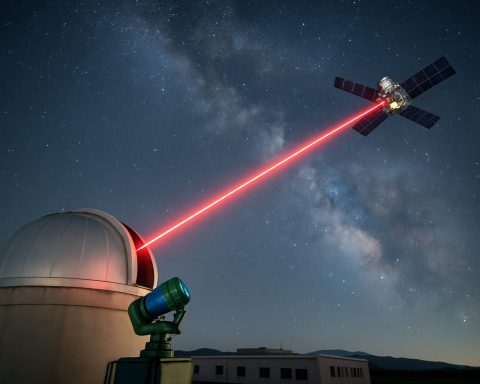- NVIDIA unveiled groundbreaking innovations at the GTC conference, emphasising AI as a transformative force in various sectors.
- The Blackwell architecture and upcoming Rubin chips promise to significantly enhance AI model training and data transfer capabilities.
- NVIDIA’s DGX AI systems, powered by Blackwell Ultra chips, aim to democratise AI tool access for developers managing expansive models.
- New silicon photonics networking chips are set to enhance efficiency and reduce energy use in AI factories.
- Cosmos™ world foundation models are expected to accelerate development in autonomous vehicles and robotics.
- The Isaac GR00T N1 introduces sophisticated, customisable humanoid robotic models, pushing the boundaries of AI-driven humanoid reasoning.
- Despite revolutionary announcements, investor reactions were muted, with analysts viewing NVIDIA’s innovations as outpacing immediate financial returns.
- Long-term prospects in AI-integrated solutions offer substantial opportunities, promising a significant technological revolution.
The air was electric as NVIDIA CEO Jensen Huang took the stage at the GTC conference, a sea of tech aficionados and industry titans waiting with bated breath. The announcements, wrapped in a vision for the future, meticulously charted a path where AI isn’t just a tool but a transformative force reshaping entire sectors.
At the heart of NVIDIA’s innovation is its new suite of chips and architectures. The Blackwell architecture, already reveling in its potential, promises to amplify AI model training and inference capabilities like never before. It’s a triumph of engineering, and with the debut of Blackwell Ultra, the pace of technological evolution shows no signs of slowing. The unveiling of the forthcoming Rubin chips marks another leap forward, offering faster data transfers, a nod to the trailblazing astronomer Vera Rubin. Set for 2026, these chips pledge to surpass the achievements of Blackwell, with the Rubin Ultra and Feynman architectures queued to dazzle in consecutive years.
As the GTC conference unfolded, NVIDIA’s ambitions were laid bare with the introduction of its DGX AI systems. These systems, intricately powered by Blackwell Ultra chips, are crafted to democratise access to AI tools, assisting developers in handling expansive models. Beyond internal innovations, NVIDIA is casting a wide net—its silicon photonics networking chips are set to weave AI factories with a sprawling network of GPUs across vast distances, ensuring enhanced efficiency and reduced energy use.
In the realm of AI-driven development, NVIDIA’s Cosmos™ world foundation models are poised to be game-changers. Designed to accelerate advancements in autonomous vehicles and robotics, these models promise to propel physical AI capabilities into the stratosphere. Simultaneously, the NVIDIA Omniverse and Cosmos platforms offer developers robust blueprints to generate vast swaths of synthetic data, speeding up post-training efforts for robots and self-driving technology.
NVIDIA’s commitment to shaping the AI landscape extends to humanoid robotics. With the introduction of Isaac GR00T N1, the world witnesses its first open, fully customisable foundation model aimed at humanoid reasoning and skills. This isn’t just about machines mimicking human behaviour; it’s about crafting tools that can adapt and evolve alongside us.
Yet, amid these groundbreaking announcements, investors have remained cautious. Some observed the stock’s minor dip post-conference, a curiosity considering GTC’s history of buoying NVIDIA’s market standing. Analysts provide a nuanced view: NVIDIA’s lustrous innovations overshadow immediate financial gains—demand for AI infrastructure is seen by some as the true harbinger of future success.
As NVIDIA continues to lead the charge, it stands on the cusp of an AI renaissance, setting benchmarks with each innovation. For the discerning investor, the allure is undeniable, yet navigating this digital frontier requires both vision and patience.
In examining NVIDIA’s narrative, the takeaway is clear: while immediate gains may fluctuate, the long-term trajectory of AI-integrated solutions signals profound opportunities. Those poised to ride this wave are likely to find themselves at the forefront of the next great technological revolution.
NVIDIA’s AI Revolution: Unveiling Future Prospects and Potential
NVIDIA has once again amazed the tech world with innovations from the GTC conference. These announcements not only shape the future of AI, but offer a substantial impact across various sectors, promising to reshape industries globally. Below are additional insights, forecasts, and expert reviews that unveil the depth and breadth of NVIDIA’s impact on AI and technology.
New Innovations and Technologies
1. Blackwell Architecture and Chips:
– The Blackwell Ultra, a leap from previous architectures, is designed to improve AI training and inference capabilities significantly. According to analyst reports, it enhances machine learning model performance by up to 30% compared to its predecessors.
2. Rubin Chips and Future Releases:
– Named after the renowned astronomer Vera Rubin, the Rubin chips are set to disrupt the tech industry by surpassing Blackwell’s achievements. Launching in 2026, Rubin Ultra and Feynman architectures will ensure unprecedented speeds in data processing and hardware efficiency.
3. DGX AI Systems:
– These systems integrate Blackwell Ultra, spreading AI tools across developers to handle large models seamlessly. Positioned as building blocks for AI factories and deep learning infrastructure, they are expected to democratise access to sophisticated AI functionalities.
4. Silicon Photonics Networking Chips:
– These chips will likely optimise GPU networking across long distances, promising improved efficiency and reduced energy consumption—a nod towards sustainable development in AI infrastructures.
Real-World Applications and Use Cases
– Autonomous Vehicles and Robotics:
– NVIDIA’s Cosmos™ models are tailored to elevate AI-driven advancements, lending massive support to robotics and autonomous vehicle technologies. Their integration is expected to reduce road incidents and enhance human-machine interactions across various domains.
– Synthetic Data Generation for AI Training:
– Platforms like Omniverse and Cosmos support developers by providing vast synthetic data for training algorithms, leading to rapid prototyping and implementation in real-world scenarios.
Market Trends and Predictions
The AI hardware and software market is set to expand exponentially, with NVIDIA positioned as a key player. With AI’s increasing adoption across industries, the demand for NVIDIA’s state-of-the-art technology is expected to drive substantial revenue growth in the coming years.
Pros and Cons Overview
Pros:
– Unparalleled AI processing power enabling sophisticated applications in various fields.
– Pioneering sustainable technology through efficient energy use.
– Robust developer support fostering innovation.
Cons:
– High initial investment costs for adopting new architecture and technology.
– Market volatility risks linked with the rapid pace of technological change.
Security and Sustainability
NVIDIA’s push towards sustainable tech solutions through energy-efficient chips is noteworthy. This aligns with global trends emphasising carbon footprint reduction, offering businesses economically and environmentally viable AI solutions.
Actionable Recommendations
For those looking to integrate NVIDIA’s latest offerings:
– Stay updated with NVIDIA’s upcoming chip releases to identify opportunities for integration and innovation.
– Leverage Omniverse and Cosmos platforms for cost-effective AI model training and data augmentation.
Conclusion
NVIDIA stands as a beacon in AI innovation. While immediate stock market responses fluctuate, the long-term potential of these technologies promises transformative growth and impact. For more information on NVIDIA’s exciting array of products and their revolutionary roadmap, explore the official NVIDIA website at NVIDIA. By aligning with these developments, enterprises can unlock new efficiencies and competitively position themselves in an increasingly AI-driven world.









